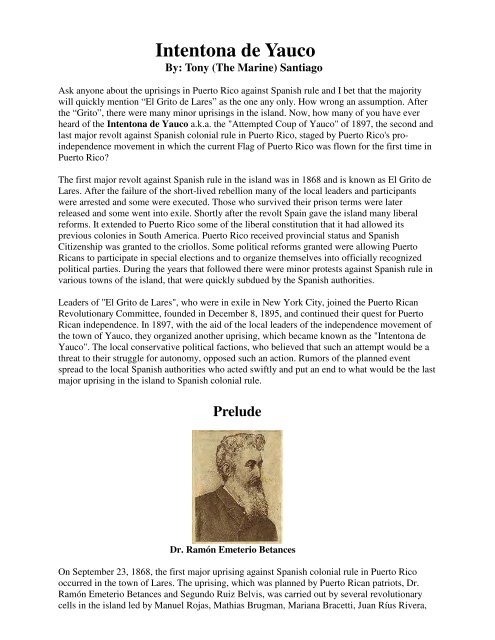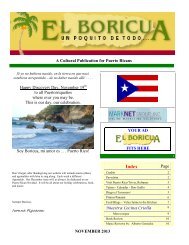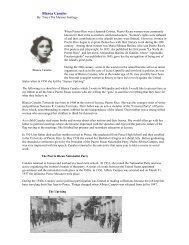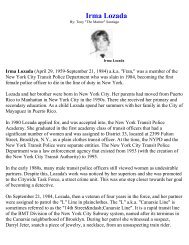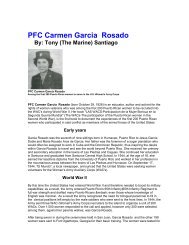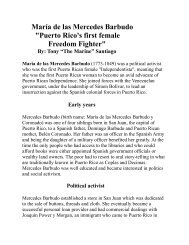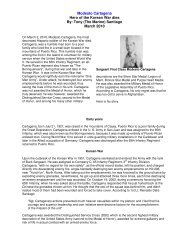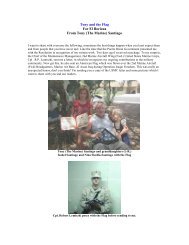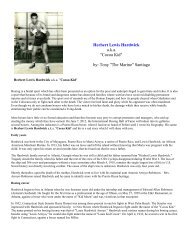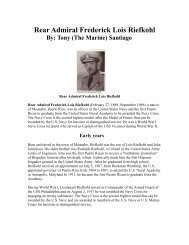Intentona de Yauco - El Boricua
Intentona de Yauco - El Boricua
Intentona de Yauco - El Boricua
- No tags were found...
Create successful ePaper yourself
Turn your PDF publications into a flip-book with our unique Google optimized e-Paper software.
Terreforte was named by the committee as its Vice-Presi<strong>de</strong>nt. In 1892, Terreforte and themembers of the Revolutionary committee adopted the <strong>de</strong>sign (which is the current <strong>de</strong>sign) of aflag similar to the Cuban flag, but with its colors inverted, as the flag to represent the Republic ofPuerto Rico.<strong>Intentona</strong> <strong>de</strong> <strong>Yauco</strong>Antonio Mattei LluberasIn 1896, a group of "Yaucanos" (as the natives of <strong>Yauco</strong> are known) who believed in fullin<strong>de</strong>pen<strong>de</strong>nce of Puerto Rico joined forces and met in Barrio Barinas of <strong>Yauco</strong> where they ma<strong>de</strong>plans to overthrow the government. The group was led by Antonio Mattei Lluberas, a wealthycoffee plantation owner, and Mateo Mercado. On December of that year, the local Civil Guarddiscovered their plans and procee<strong>de</strong>d to arrest all those involved who, besi<strong>de</strong>s Mercado andMattei Lluberas, inclu<strong>de</strong>d Dario and Carlos Franchesi and Emiliano Lavergue, however theywere soon released and returned to their respective homes.In 1897, Mattei Lluberas visited the Puerto Rican Revolutionary Committee in New York City.There he met with Ramon Emiterio Betances, Juan <strong>de</strong> Mata Terreforte and Aurelio Mén<strong>de</strong>zMartinez and together they procee<strong>de</strong>d to plan a major coup. The uprising was to be directed byBetances, organized by Men<strong>de</strong>z Mercado and the armed forces were to be comman<strong>de</strong>d byGeneral Rius Rivera. At the time Ríus Rivera, who joined José Martí's struggle for Cubanin<strong>de</strong>pen<strong>de</strong>nce as a member of the Cuban Liberation Army, was the Comman<strong>de</strong>r-in-Chief of theCuban Liberation Army of the West. In accordance to the plan, Mattei Lluberas purchased30,000 machetes which were to be distributed amongst the rebels. Mattei Lluberas returned toPuerto Rico with a Puerto Rican flag and began to proceed with the plans of the revolt with hisgroup. The Bu<strong>de</strong>t Rivera brothers established an insurgent training camp in the farm of GullermoVelazco. Fellow rebels, Gerardo Forest Velez and Agustin F. Morales (himself a general in theArmy of the Dominican Republic), were in charge of propaganda and traveled throughout theisland seeking public support for their cause. Cuban revolutionist Tomas Estrada Palma, offereda contribution of 500 rifles with half a million rounds of ammunition and his comra<strong>de</strong> offered asteamship with an invading force of 200 men un<strong>de</strong>r the command of General Agustin F.Morales. The revolution was set for the beginning of the month of December 1897.The political situation at the time in Puerto Rico was different then the one in 1868, when "<strong>El</strong>Grito <strong>de</strong> Lares" occurred. Luis Muñoz Rivera and his Autonomist party had signed a pact withPraxe<strong>de</strong>s Mateo Sagasta, the lea<strong>de</strong>r of the Spanish Liberal Party, which stated that if he (Sagasta)and the liberals assumed power in Spain, he would grant Puerto Rico autonomy. Thus, thepolitical lea<strong>de</strong>rs of Puerto Rico believed that any attempt by the separatist movement to seek full
in<strong>de</strong>pen<strong>de</strong>nce for the island would be a threat to what they were trying to accomplish and insteadof being granted more autonomy, the island would be <strong>de</strong>alt with harshly by the Spanishauthorities. Therefore, when the Mayor of <strong>Yauco</strong> Francisco Lluch Barreras heard the rumors ofthe planned uprising, he immediately notified General Sabas Marín González the governor of theisland.Flag flown by Fi<strong>de</strong>l Vélez and his men during the "<strong>Intentona</strong> <strong>de</strong> <strong>Yauco</strong>" revoltFi<strong>de</strong>l Velez, a native of Sabana Gran<strong>de</strong> and one of the separatist lea<strong>de</strong>rs, found out that theSpanish authorities knew about their plans and immediately held a meeting with Mattei Lluberasand the other lea<strong>de</strong>rs. Fearing that they all would soon be arrested, he <strong>de</strong>man<strong>de</strong>d that theinsurrection start immediately and not in December. In the discussion that followed, the otherlea<strong>de</strong>rs did not agree with him, fearing that such a haste action would lead to the same disastrousresults of <strong>El</strong> Grito <strong>de</strong> Lares.On March 24, 1897, Fi<strong>de</strong>l Velez and his men met at Susua Arriba, just outsi<strong>de</strong> of <strong>Yauco</strong>. Theyunfurled the Puerto Rican flag for the first time in Puerto Rican soil and marched towards thetown. They planned to attack the barracks of the Spanish Civil Guard with the aim of gainingcontrol of the arms and ammunition, that were stored there. The plan did not succeed becausewhen they arrived they were ambushed by the Spanish forces, who had set up positions and werewaiting for them. A firefight ensued upon the arrival of the group and the rebels quicklyretreated. On March 26, another group hea<strong>de</strong>d by Jose Nicolas Quiñones Torres and RamonTorres attempted to fight the Spaniards in a barrio called "Quebradas" of <strong>Yauco</strong>, however saidrevolt also failed. Over 150 rebels were arrested, accused of various crimes against the state andsent to prison in the City of Ponce. Velez fled to St. Thomas where he lived in exile, whileMattei Lluberas went into exile in New York City and joined a group known as the "PuertoRican Commission".AftermathSagasta's party won the elections in Spain and on November 25, 1897, Spain granted Puerto Ricoautonomy. Muñoz Rivera served as Secretary of Grace, Justice and Government and Chief of theCabinet for the in<strong>de</strong>pen<strong>de</strong>nt Government of Puerto Rico. In December 1897, those whoparticipated in the <strong>Intentona</strong> <strong>de</strong> <strong>Yauco</strong> were granted clemency and released from jail.Following the sinking of the battleship Maine in Havana harbor, Cuba, the United Statesforwar<strong>de</strong>d an ultimatum to Spain to withdraw from Cuba. In response, Spain broke offdiplomatic relations with the United States, and on April 23, 1898, Spain <strong>de</strong>clared war. On April25, the U.S. Congress <strong>de</strong>clared that a state of war between the United States and Spain ha<strong>de</strong>xisted since April 20. One of the United States' principal objectives in the Spanish-AmericanWar was to take control of Spanish possessions in the Atlantic — Puerto Rico and Cuba.


